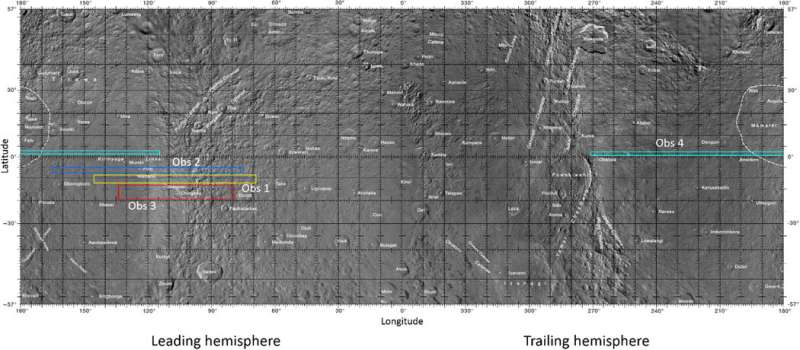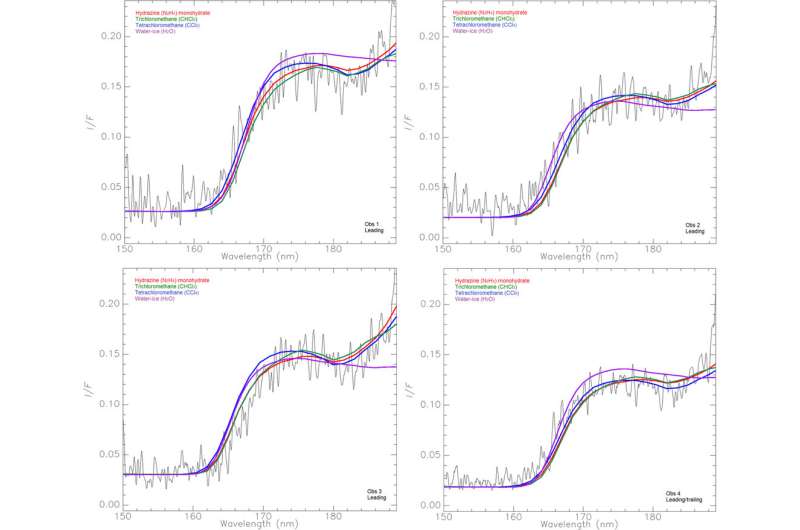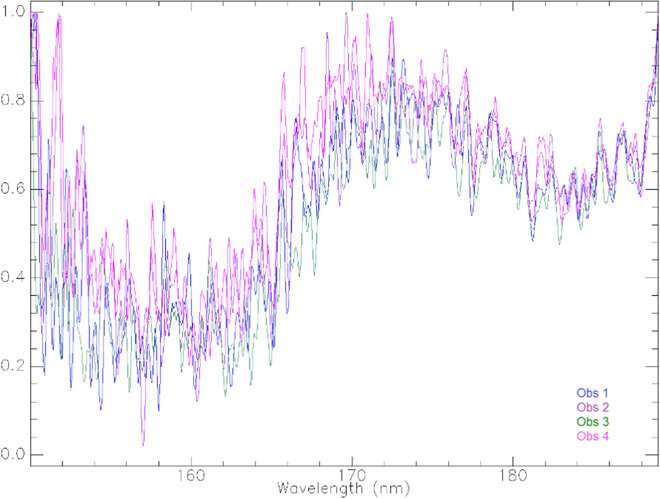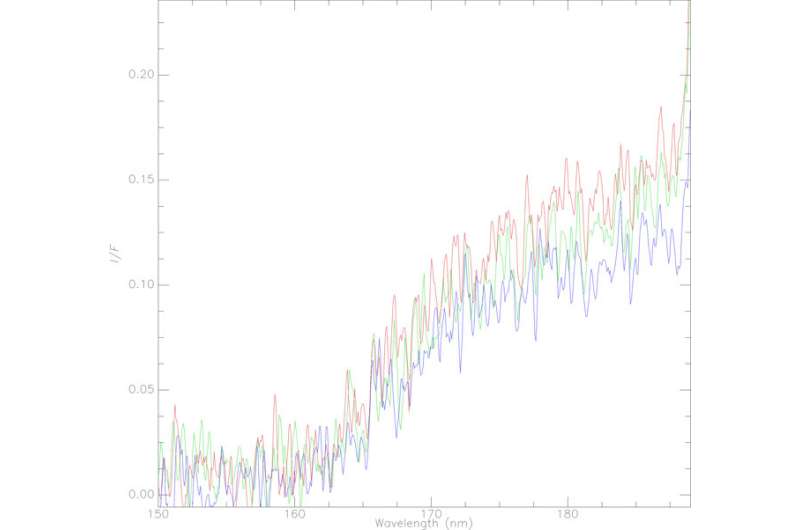February 4, 2021 feature
Possible detection of hydrazine on Saturn's moon Rhea

In a new report on Science Advances, Mark Elowitz, and a team of scientists in physical sciences, optical physics, planetary science and radiation research in the U.S., U.K., India, and Taiwan, presented the first analysis of far-ultraviolet reflectance spectra of regions on Rhea's leading and trailing hemispheres—as collected by the Cassini ultraviolet imaging spectrograph during targeted flybys. In this work, they specifically aimed to explain the unidentified broad absorption feature centered near 184 nanometers of the resulting spectra. Using laboratory measurements of the UV spectroscopy of a set of molecules, Elowitz et al. found a good fit to Rhea's spectra with both hydrazine monohydrate and several chlorine-containing molecules. They showed hydrazine monohydrate to be the most plausible candidate to explain the absorption feature at 184 nm. Hydrazine was also a propellant in Cassini's thrusters, however, in this instance, the thrusters were not used during icy satellite flybys and therefore the signal was assumed to not rise from spacecraft fuel. The scientists then detailed how hydrazine monohydrate may be chemically produced on icy surfaces.
Saturn's moon Rhea
Knowledge of the geology and surface topography of Saturn's second largest moon Rhea had advanced greatly by several flybys during the Cassini-Huygens mission. The surface of Rhea is heavily cratered with geomorphological features to indicate endogenic activity such as large impact craters in the north-south direction. The surface temperature of Rhea can change from about 40 to 100 K, with high visible geometric albedo. The albedo, i.e., the amount of light reflected from a celestial object, was consistent with a surface composed of water-ice, typically supported by the measurement of infrared (IR) absorption features. In general, Rhea orbits Saturn at a distance approximating 8.75 Saturn radii with a velocity of 8.5 Km/s, where its traveling hemisphere is irradiated by plasma traveling at approximately 57 Km/s. The E-ring grains of Saturn could bombard and coat much of the surface of Rhea, and such bombardments from different sources could cause chemical changes in the irradiated surface to synthesize a rich surface chemistry. However, the surface composition of Rhea currently remains largely unknown. In this work, Elowitz et al. used four Cassini ultraviolet imaging spectrograph/far ultraviolet (UVIS/FUV) disk-resolved observations of Rhea. To reduce the noise in the data, the researchers applied a smoothing filter. They noted the spectra to be dominated by water-ice absorption features, as noted in previous icy satellites. They explored explanations for broad absorption spectra across the wavelength range approximating 179-to-189 nm in the UVIS spectra of Rhea.

Examining the surface chemistry of Rhea
The scientists measured the laboratory spectra of several molecular species and their mixtures to derive optical constraints. Rhea and Dione are generally known to share similar geomorphology based on the Cassini high-resolution Imaging Science Subsystem (ISS). Both mid-sized icy satellites consisted of an oxygen/carbon dioxide exosphere with similar compositional and photometric properties. Both Rhea and Dione exhibited brighter leading hemispheres with very little limb darkening at low phase angles. The team credited the brighter hemispheres to the deposition of pure water-ice from Saturn's E-ring, where both Rhea and Dione showed similar photometric properties alongside orange/violet color ratios to imply the similarity of their surfaces. They obtained the resulting model spectra of hydrazine monohydrate (N2H4.H2O) and trichloromethane (CHCl3) below a layer of water-ice using laboratory absorbance measurements and the Hapke theory. After examining the modeled spectra, Elowitz et al. showed the presence of hydrazine monohydrate or chloromethane molecules to explain the weak, broad absorption seen between 179 and 189 nm regions. The results did not show significant variations in the band strength across observations or locations on Rhea.

The origins of chlorine compounds on Rhea
The team next explored possible sources and sinks of each molecular species, to understand the chemical compounds responsible for the weak absorption spectra from the region of interest. They hypothesized the presence of a source for carbon tetrachloride (CCl4) on Rhea, followed by a fresh layer of water-ice delivered on top of that from Saturn's E-ring. The UV reflectance spectroscopy technique was only sensitive to the upper few micrometers, allowing the scientists to detect a layer of chloromethane compounds beneath the water-ice depositions. However, it was still difficult to explain the presence of chlorine compounds via chemical pathways on Rhea since their origin required the presence of an internal ocean layer or exogenic delivery by micrometeoroids or asteroids containing chlorine. For instance, if the compounds existed deeply in the interior of Rhea, they could depress the freezing point of water-ice to increase the probability of an aqueous layer. Researchers had previously detected chlorine-based salts such as sodium chloride on plumes of Enceladus as evidence for an internal ocean. However, it was unlikely for chlorine compounds to migrate to the surface of Rhea through cracks in the ice shell due to the comparatively greater depth of its liquid layer. The remaining possible source of chlorine was via exogenic delivery by chondritic asteroids throughout history. The condensed chlorine may have then been redistributed to other regions of the satellite through sputtering induced by charged particles from Saturn's magnetosphere, to explain the wide distribution of sampled chlorine compounds.

Understanding the production of hydrazine monohydrate on Rhea
In comparison to chloromethane, the production of hydrazine monohydrate was easier to explain due to chemical reactions involving water-ice and ammonia or delivery from Titan's nitrogen rich atmosphere. Elowitz et al. considered the possibility of contamination of the UVIS data by a hydrazine propellant from the Cassini spacecraft, although it was highly unlikely since the hydrazine thrusters were not used during icy satellite flybys. The team confirmed the specific signature of a 184-nm feature on Rhea's surface using the UV spectrometer observations made by the Cassini spacecraft. In addition to that, the irradiation of ammonia by charged particles from Saturn's magnetosphere induced the dissociation of ammonia molecules to form diazene and hydrazine. The source of ammonia on Rhea could be primordial, incorporated into its interior during formation and brought to the surface within a period of endogenic activity, as evident in Cassini ISS imagery, although ammonia was unlikely to survive indefinitely on the surface. The team suggest further analysis to understand the potential for satellite-to-satellite transfer of materials across Titan's atmosphere to explain the presence of hydrazine monohydrate on Rhea.

Outlook
In this way, Mark Elowitz and colleagues detailed the first geochemical survey of Saturn's moon Rhea's icy surface in the far ultraviolet region. The results indicated the possible presence of chloromethane compounds under a layer of water-ice, or the presence of a hydrazine monohydrate complex. They assumed hydrazine to be the predominant candidate for the observed UV spectral features at 184 nm, compared to chloromethane compounds. The team credited the presence of ammonia within the icy upper layer on Rhea to be the source of hydrazine monohydrate. The researchers intend to also explore the possibility of hydrazine synthesis in the atmosphere of Saturn's largest moon Titan and its transfer from satellite-to-satellite to reach Rhea across geological timespans.
More information: Elowitz M. et al. Possible detection of hydrazine on Saturn's moon Rhea, Science Advances, 10.1126/sciadv.aba5749
Teolis B. D. et al. Cassini finds an oxygen–carbon dioxide atmosphere at Saturn's icy Moon Rhea, Science, 10.1126/science.1198366
Postberg F. et al. Sodium salts in E-ring ice grains from an ocean below the surface of Enceladus, Nature, doi.org/10.1038/nature08046
Journal information: Science Advances , Nature , Science
© 2021 Science X Network





















